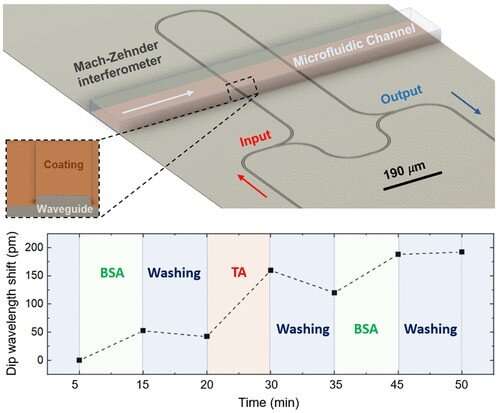This article has been reviewed according to Science X's editorial process and policies. Editors have highlighted the following attributes while ensuring the content's credibility:
fact-checked
peer-reviewed publication
trusted source
proofread
Scientists present new application for nanophotonic sensor

A joint research team from Skoltech, HSE, MPGU and MISIS has developed a compact sensor for biochemical analysis, opening up a new frontier in the development of the "lab-on-a-chip." Using bovine serum albumin film as an example, the researchers proved that the chip surface can be adapted for selective analysis of multicomponent solutions. Along with enabling accurate blood tests with only 3 to 5 microliters of blood, the chip will help doctors to detect specific disease markers. The study was published in Analytical Chemistry.
"Although as small as a five-ruble coin, the chip can accommodate dozens of sensitive devices and microfluidic channels. Moreover, you can modify a sensor's surface and create a prototype lab-on-a-chip," notes Grigory Goltsman, professor at MIEM HSE and MPGU and co-developer of the new technology.
Almost every medical examination starts with a test and, most often, a blood count showing hemoglobin, red and blood cell levels, etc. Sometimes only one component is required to assess a patient's condition. For example, you might need to determine the number of exosomes—microscopic extracellular vesicles which in large quantities may be a sign of cancer.
For test purposes, laboratories use sensitive sensors with a surface covered in a special coating that binds only to specific exosomes and picks them out from the solution for analysis. Some devices require a multi-step procedure, including coating application and quality checks on another instrument. The authors showed a way to simplify the test by checking the surface quality using on-chip sensors.
To do this, they applied thin protein films on the chip substrate and performed a series of experiments. The chip consists of three parts: microfluidic channels carrying the substance, a silicon nitride substrate beneath the coating, and photonic integrated circuits (PICs) for measuring the substance's optical density. The microfluidic channel is located above the sensitive part of the PIC devices.
In a Mach-Zehnder interferometer, an optical beam injected into the system is split into two parts, one directed into the upper arm above the microfluidic channel containing the substance and the other into the lower arm for comparison, which is not affected by anything. The change in optical density is found from the difference in the optical path length between the lower and upper arms.
In the experiments, the researchers deposited protein and tannic acid films layer by layer onto the sensitive surface of the PICs. After pumping bovine serum albumin through the microfluidic channels, they washed out the excess albumin with deionized water, pumped in tannic acid, reapplied the protein coating and analyzed the deposition process for each layer in real time using optical readings from the interferometer.
"The optical sensors on the chip have high sensitivity but low specificity to solution components. First, we have succeeded in increasing their specificity by dressing the surface with a layer of molecules sensitive to a single component. Second, the sensor itself monitored the coating process in real time," explains Skoltech professor Dmitry Gorin.
The team will continue to work on the "lab-on-a-chip"—a device that can analyze several components simultaneously using a minimum volume of biological samples, such as a drop of blood. To do this, the researchers plan to increase the number of PICs on the chip.
"Simultaneous operation of all the sensors on the chip with a modified surface of each channel will help to check from 3 to 5 microliters of blood for markers and come up with a preliminary diagnosis," says Aleksei Kuzin, HSE graduate, Skoltech Ph.D. student and co-author of the study.
More information: Aleksei Kuzin et al, In Situ Monitoring of Layer-by-Layer Assembly Surface Modification of Nanophotonic-Microfluidic Sensor, Analytical Chemistry (2022). DOI: 10.1021/acs.analchem.2c03909
Journal information: Analytical Chemistry
Provided by Skolkovo Institute of Science and Technology





















